Let’s pay more attention to forest soils, they regenerate very slowly
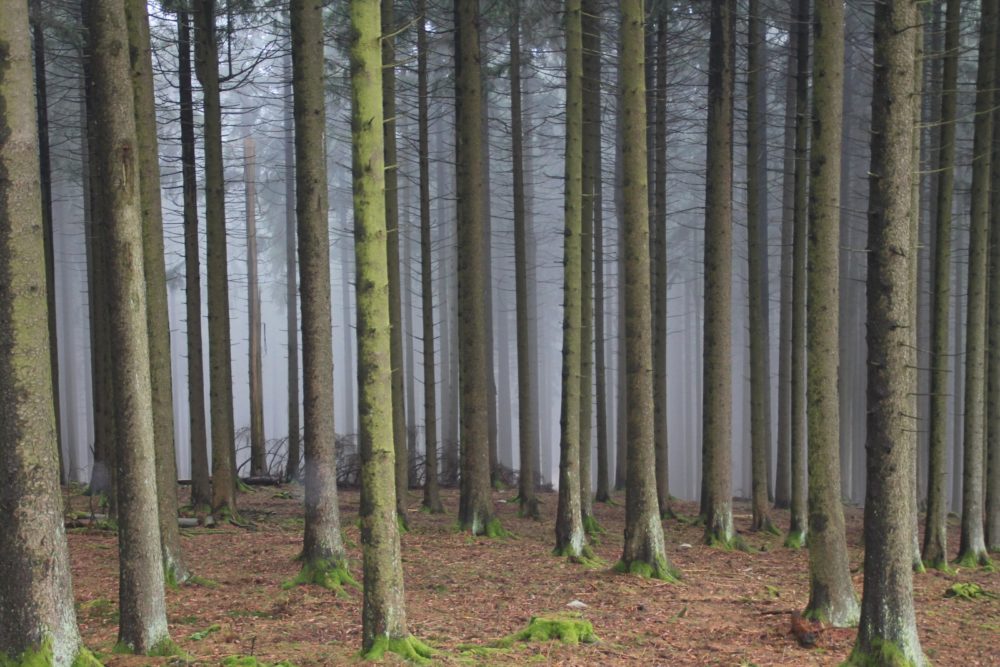 Acidification of forest soils in the Czech Republic is accelerated by human activity and it has an adverse effect on the health status of forests. The removal of woody biomass from the forest contributes significantly to this acidification, since it removes a large amount of nutrients from biochemical natural cycles. A faster regeneration of the soil environment would benefit from a reduction in acidic nitrogen deposition, from an increase in the proportion of deciduous trees in the species composition together with a reduction in the balance of biomass from forest stands.
Acidification of forest soils in the Czech Republic is accelerated by human activity and it has an adverse effect on the health status of forests. The removal of woody biomass from the forest contributes significantly to this acidification, since it removes a large amount of nutrients from biochemical natural cycles. A faster regeneration of the soil environment would benefit from a reduction in acidic nitrogen deposition, from an increase in the proportion of deciduous trees in the species composition together with a reduction in the balance of biomass from forest stands.
Currently, there are removed not only stems during logging from forests, but also branches or even roots, i.e. the parts that accumulate the largest amount of basic (alkaline) cations (nutrients). Tens to hundreds of kilograms of calcium, magnesium, potassium and other nutrients are lost from one hectare of forest soil by their removal.
The reaction of forest soils in the Czech Republic is also influenced by the change in the natural species composition in favour of conifers, especially of Norway spruce. Its acidifying effect on the upper soil layers has been documented in many studies. It is reported that spruce litter (conifers) can acidify the upper soil layers already within one or two generations of the forest.
However, in the middle and lower soil layers, acidification is attributed rather to the effect of acid deposition (deposition of compounds) from polluted air.
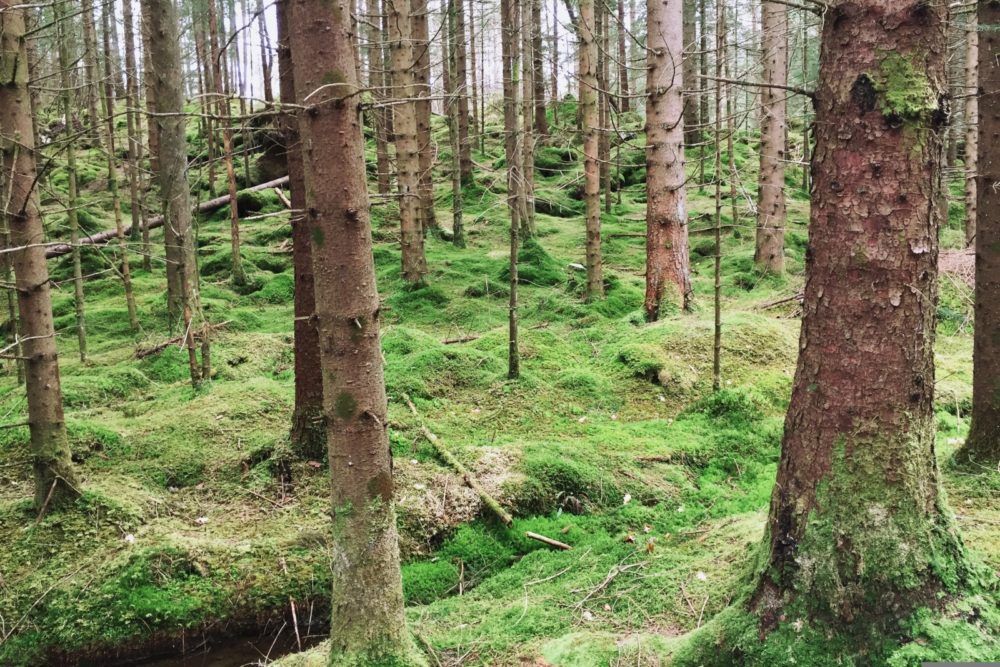 Photo: Norway spruce forest, where soil acidification is significant; this manifests itself, in the fact that mosses begin to predominate in the herb layer, for example.
Photo: Norway spruce forest, where soil acidification is significant; this manifests itself, in the fact that mosses begin to predominate in the herb layer, for example.
Increased deposition (deposition) of acidic particles into the soil environment due to anthropogenic activities, it is dated back to the mid-19th century. In our territory, the entry of acidifying compounds, especially sulphur and nitrogen oxides, was the most intensive during the 1970s and 1980s. Due to the high concentration of thermal (coal) power plants and heating enterprises, probably the highest amount of SO2 a NO2 emissions in the world was produced in the area of the Mostecka basin (Mostecká pánev) area.
After significant socio-economic changes in 1989 and the desulphurization of coal power plants and other main sources of pollution, an enormous decrease in the deposition of acidifying compounds was recorded in the Czech Republic territory.
Despite the significant reduction in the leaching of basic cations from the soil environment, the process of regeneration of the soil environment is very long-term and gradual, limited both by slow weathering processes and the effects of forestry management described above.
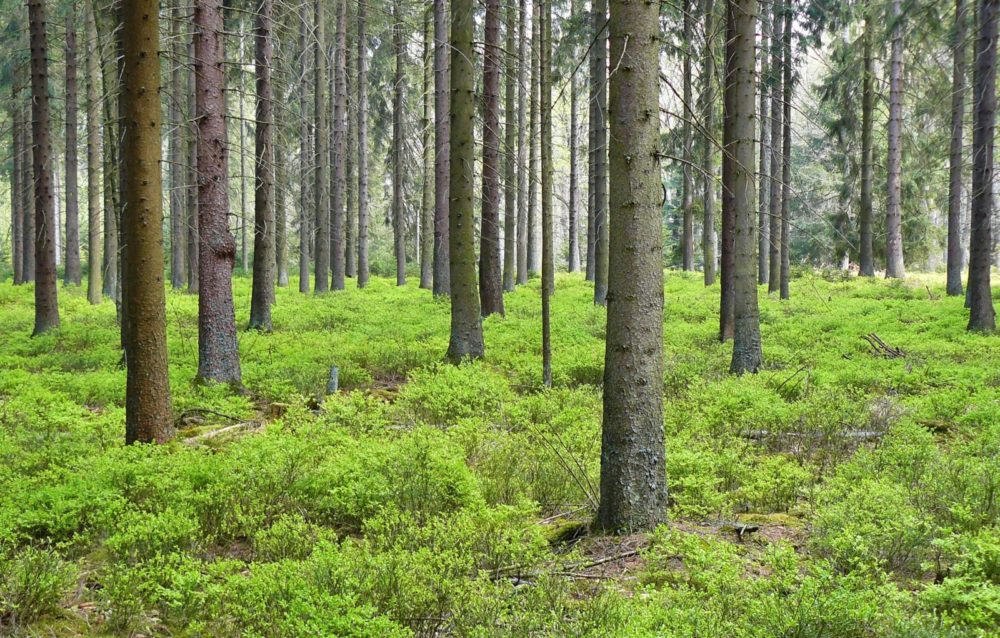 Changes in pH /* (acidity – alkalinity) of forest soils under anthropogenic load and scenarios of future development are most often assessed using biogeochemical acidification models. However, these models are characterized by a limited input of real soil data. A more precise evaluation is provided by studies based on the comparison of data sets with long time intervals, but just there are not too much of such publications disposable.
Changes in pH /* (acidity – alkalinity) of forest soils under anthropogenic load and scenarios of future development are most often assessed using biogeochemical acidification models. However, these models are characterized by a limited input of real soil data. A more precise evaluation is provided by studies based on the comparison of data sets with long time intervals, but just there are not too much of such publications disposable.
The specialists of the Forest Management Institute, Brandýs n. L., are dealing with the mentioned issue and they published their results in the paper Acidification and regeneration of forest soils in the Czech Republic (Acidifikace a regenerace lesních půd v České republice), which was published in the journal Reports of Forest Research No. 1/2023.
The aim of their work was to evaluate the development of pH in selected localities and to reconstruct the development of the pH of forest soils in the Czech Republic from the 1950s to the present.
In the experiment, there are included data from two types of research trials. These trials were established on the Czech Republic forest lands, and the research was carried out by the staff of the Forest Management Institute (ÚHÚL), Brandýs nad Labem.
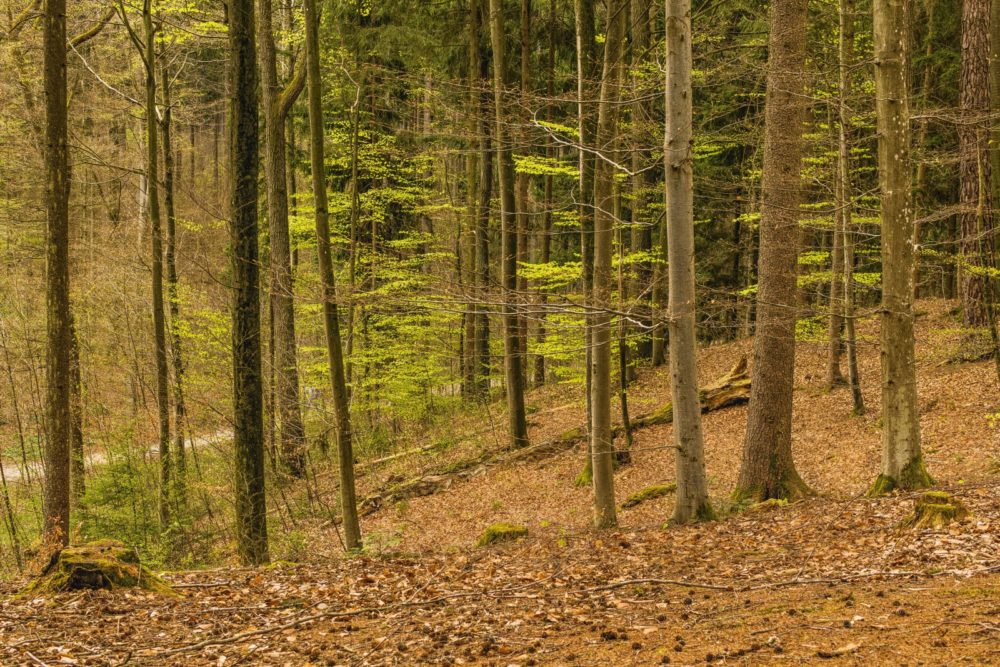 Forestry-typological trials (LTP) used to be established from the beginning of the 1950s to the present day. The primary goal of these trials network is to provide the basis for creating characteristics of forest types.
Forestry-typological trials (LTP) used to be established from the beginning of the 1950s to the present day. The primary goal of these trials network is to provide the basis for creating characteristics of forest types.
Inventory trials (IP) were established as part of the National Forest Inventory (NIL). These trials are evenly distributed in the Czech Republic, each of them is located in a 4×4 km square based on the principle of random selection. Investigations on these trials took place from 2011 to 2018.
The study results confirm a significant downward trend in soil pH since the turn of the 1960s. The lowest values were found in the 1980s, which corresponds to the greatest depositional pressure in the Czech Republic during this period. The decrease in A horizons (organo-mineral) and B horizons (mineral) exceeded one degree of pH.
In the monitored period (1953–1990), not only the forest soils of mountain locations (above 700 m above sea level /a. s. l. /), were affected by intensive acidification, but also middle locations (400–700 m a. s. l.) and lower locations (below 400 m a. s. l.), were affected, too.
A significant decreasing of pH was demonstrated both in lower locations up to 400 m a. s. l. (Central Bohemian Upland /Středočeská pahorkatina/, Giant Mountains Foothills /Podkrkonoší/, Eagle Mountains Foothills /Předhoří Orlických hory/, South Moravian Basins /Jihomoravské úvaly/) and also in middle locations in the range of 400–700 m a. s. l. (Ore Mountains /Krušné hory/, West Bohemian Uplands /Západočeská pahorkatina/, Křivoklátsko Protected Landscape /Chráněná krajinná oblast Křivoklátsko/, Bohemian Karst /Český Kras/, Rakovník – Kladno Uplands /Rakovnicko-kladenská vrchovina/, Central Bohemian Upland /Středočeská pahorkatina/, Bohemian Forest /Český les/, Czech-Moravian Intermountain /Českomoravské mezihoří/, White Carpathians /Bílé Karpaty) and Vizovice Hills /Vizovické vrchy/).
Also, the decreasing of pH has been registered in localities 700 m a. s. l. in the Czech Republic state border mountains (Ore Mountains /Krušné hory/, Bohemian Forest /Český les/, Giant Mountains /Krkonoše/). In the Jizera Mountains /Jizerské hory/, there decreasing of pH has not been registered.
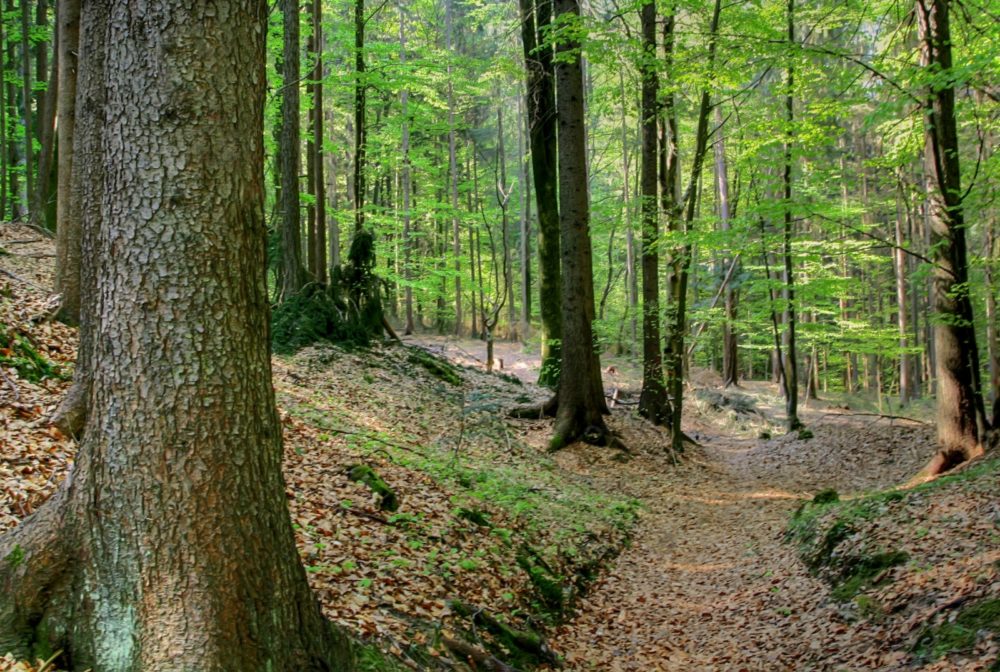 Photo: In a mixed forest, leaf fall from deciduous trees improves the quality of the soil and contributes to its gradual regeneration
Photo: In a mixed forest, leaf fall from deciduous trees improves the quality of the soil and contributes to its gradual regeneration
Significant acidification was also detected on trials repeatedly sampled in the 1950s and then in the 1990s, as well as on trials repeatedly sampled in the 1950s and subsequently in the 1970s. Lower (below 400 m a. s. l.), middle (400–700 m a. s. l.) and higher (above 700 m a. s. l.) trials were sampled.
The trend of soil environment regeneration since the early 1990s was detected in all locations and in the entire soil depth. However, what is surprising, this is that the return to the original values is very gradual and only reaches a few tenths of a degree of pH.
A significant trend of regeneration of the soil environment after 2000 was detected in the Jizera Mountains and Ještěd Hill.
After 2010, the return to the original pH values stagnated. In locations above 700 m a. s. l., soil regeneration is slower compared to lower locations (below 400 m a. s. l. and 400–700 m a. s. l.).
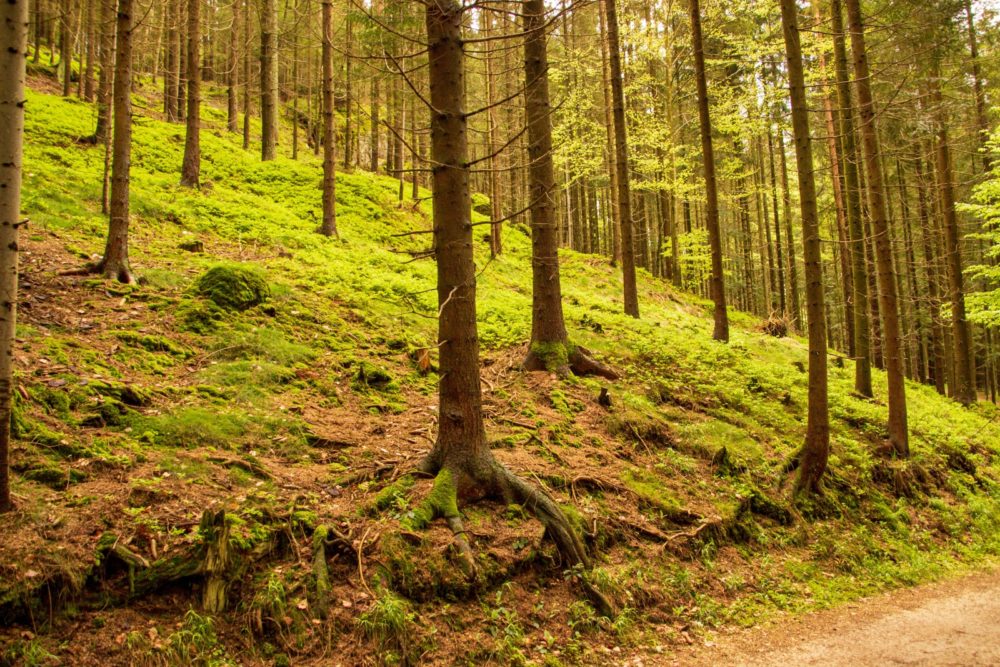 A more rapid regeneration of the soil environment would benefit from a reduction in acidic nitrogenous deposition, together with an increase in the proportion of deciduous trees in the species composition and a reduction of “Derbholz”/** removing from forest stands.
A more rapid regeneration of the soil environment would benefit from a reduction in acidic nitrogenous deposition, together with an increase in the proportion of deciduous trees in the species composition and a reduction of “Derbholz”/** removing from forest stands.
Paper Acidification and regeneration of forest soils in the Czech Republic (Acidifikace a regenerace lesních půd v České republice) can be downloaded here.
Authors of paper: Jan Pecháček, Dušan Vavříček, Jana Čermáková, Forest Management Institute (Ústav pro hospodářskou úpravu lesů), Brandýs nad Labem, Branch Office (Pobočka) Brno, e-mail: Pechacek.Jan@uhul.cz
Prepared according to the paper by Ing. Jan Řezáč, FGMRI (VÚLHM, v. v. i.), e-mail: rezac@vulhm.cz
Footnotes:
/* Soil pH is the measure of soil acidity or alkalinity, specifically the inverse log of the Hydrogen ion concentration on a scale from 0-14. Neutral pH is around 7, with ‘acids’ being below 7 and ‘bases’ being from 7 to 14.
/** „Derbholz“– timber to the top of 7 cm diameter.
